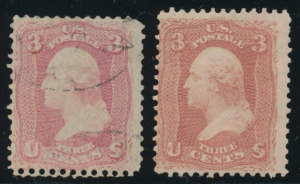 One area where the Scott catalog is inconsistent and unreliable concerns shades. Most stamps of the Nineteenth Century exist in numerous shades. The reason is simple. Ink colors were hard to match and when different printings of the same stamps were made, while the printers attempted to match the inks, there was no foolproof way of matching the color exactly from one printing to the next. The Scott catalog on US stamps attempts to list most of the major shades and usually they are listed as minor varieties which is what they are. But sometimes the shades are a bit more startling or glamorous and the early catalog editors made them into entirely different Scott numbers. One of the more egregious examples of this is the Pink variety of the three cent 1861, which was given it's own catalog number (#64) as opposed to the regular red brown shade of #65. The pink is really just an early printing of #65 and it is a hard shade for many collectors to identify. The color is changeable. I have seen many certificates for Pinks issued years ago where the color has changed and the stamp would now be recertified as red brown. Further, the color doesn't show well under fluorescent light, so when I'm identifying shades of this stamp I take them to a window and use natural light. The stamp on the left is a good example of a Pink and you note that it has a bluish cast that's characteristic of this shade. Frankly if a collector were to tell me that because of the above problems he was avoiding having this variety in his collection, I would be inclined to agree with him.
One area where the Scott catalog is inconsistent and unreliable concerns shades. Most stamps of the Nineteenth Century exist in numerous shades. The reason is simple. Ink colors were hard to match and when different printings of the same stamps were made, while the printers attempted to match the inks, there was no foolproof way of matching the color exactly from one printing to the next. The Scott catalog on US stamps attempts to list most of the major shades and usually they are listed as minor varieties which is what they are. But sometimes the shades are a bit more startling or glamorous and the early catalog editors made them into entirely different Scott numbers. One of the more egregious examples of this is the Pink variety of the three cent 1861, which was given it's own catalog number (#64) as opposed to the regular red brown shade of #65. The pink is really just an early printing of #65 and it is a hard shade for many collectors to identify. The color is changeable. I have seen many certificates for Pinks issued years ago where the color has changed and the stamp would now be recertified as red brown. Further, the color doesn't show well under fluorescent light, so when I'm identifying shades of this stamp I take them to a window and use natural light. The stamp on the left is a good example of a Pink and you note that it has a bluish cast that's characteristic of this shade. Frankly if a collector were to tell me that because of the above problems he was avoiding having this variety in his collection, I would be inclined to agree with him.
Pink
Posted August 02, 2018
in News
